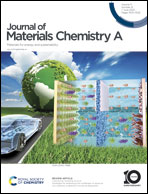Secondary interaction-manipulated metal–organic crystalline nanotube array for gas sensing†
Abstract
Although having attracted growing interest, the design and preparation of metal–organic crystalline nanotube arrays (MO-CNAs) remains a challenge. Herein, a Pb⋯S metal–nonmetal secondary interaction strategy was proposed to prepare a Pb(II)-based MO-CNA (Pb-HTT), endowing Pb-HTT with high thermal/chemical stability, a porous structure, and open metal sites. With unique unsaturated metal centers for guest accommodation, Pb-HTT exhibited the best sensing performance with both response time <0.1 min and theoretical limit of detection <0.1 ppb in comparison to all reported room-temperature NO2 chemiresistive sensing materials. It also showed highly selective sensing toward NO2 among 10 interfering gases. The experimental XANES data and theoretical calculation verified the exact active sites of Pb centers on Pb-HTT and revealed the sensing mechanism. Notably, this study not only provides a useful metal–nonmetal secondary interaction strategy for the construction of MO-CNAs, but also accelerates the application of semiconducting CNAs in structure-directed functional electronic devices.



 Please wait while we load your content...
Please wait while we load your content...